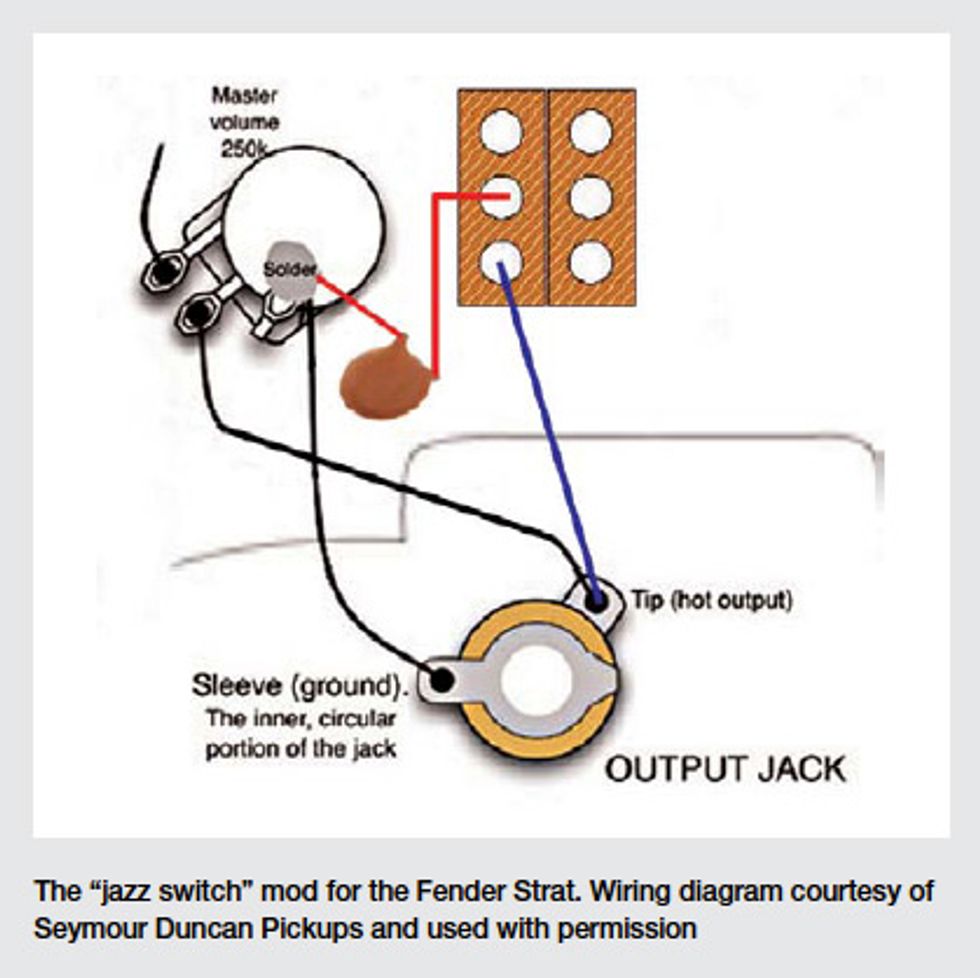This month we're checking
out another Strat mod that's
very easy to do and that offers a
lot of utility. And it's cheap! All
you need for this mod is a simple
on/off toggle and a capacitor—that's it. The idea is based
on the stock Fender Telecaster
wiring from the early '50s.
As you may know, until 1967
Fender used a different wiring
for Telecasters than the scheme
we know today. On standard
modern Teles, the wiring is
bridge pickup alone, both pickups
together in parallel, and neck
pickup alone. But prior to 1967,
Fender used the following wiring:
bridge pickup alone, neck
pickup alone, and neck pickup
alone with an additional 0.1 μF
cap engaged. (We'll explore this
old-school Tele wiring in a future
column, when we switch from
Stratocaster to Telecaster mods.)

In Fender literature from
the era, this neck-pickup-plus-capacitor
wiring was described
as a “pre-set bassy sound," and
the idea came from Leo Fender
himself. Leo believed guitarists
should have the capability of playing
bass lines without switching
instruments. After experimenting,
he came up with this solution and
the result was a boomy, bassy tone
that didn't require an additional
tone knob. This was intended as
a “bass preset" that would allow a
guitarist to simply flip the 3-way
pickup selector to enter bass territory.
For this reason, the mod I'm
about to describe is often called
the “bass switch mod."
The preset idea is something
Fender used in several other guitars
as well, including the Jaguar.
However, it turned out Tele
players didn't want to play bass
lines, and once the Fender P bass
was invented (it came soon after
the Telecaster), this bass preset
remained mostly unused or fell
victim to early modifications.
When Fender finally changed
the wiring, it was a concession
to countless customers' demands
and an admission that this preset
tone was more or less unusable.
After 1967, this wiring option
was almost forgotten. But in the
early '80s, adventurous jazz players
like Mike Stern discovered that old
Telecasters made a durable alternative
to an expensive archtop jazz
box. Suddenly, the old Fender preset
wiring was something desirable
and practical. It worked perfectly
for those dark, jazzy tones certain
guitarists were looking for, and a
new hype was born. Some players
stayed with the stock Fender wiring,
while others started to experiment
with different cap styles and
values. Leo Fender never intended
his wiring for this kind of “abuse,"
but even today, it's the standard for
a lot of jazz players all around the
world. So if you want to throw in
some cool jazz lines without messing
with your Strat's tone knobs,
this preset mod is for you.
I've adapted the preset to
accommodate any Stratocaster
wiring and to work in conjunction
with all the standard 5-way-switch
pickup combinations. To summarize:
You won't lose a switching
position on the 5-way switch,
yet you'll receive a lot of different
new tones because the mod works
with all pickup combinations. To
mimic old-style jazz tones, people
recommend using the Strat's neck
pickup, but I also like using the
bridge-and-middle pickup combination
with this mod.
First, you'll need an on/off
switching device. You can use a
mini toggle (which is what I prefer)
or any kind of push/pull or
push/push pot. The advantage of
using a pot is that your Strat will
remain visually unaltered.
Second, you'll need an extra
capacitor to throw into the circuit.
This area offers a lot of opportunity
to experiment. You can try
different cap styles—like paper-in-oil caps, foil/film caps, old-style
paper-waxed caps, ceramic, and
so on. For this application on a
Stratocaster, I prefer the warm
and growly character of new-old-stock
(NOS) paper-in-oil caps.
But there's no right or wrong—it's
only the tone that matters, so if
you like it, use it.
A cap's value (or capacitance,
to be more precise) provides even
more options to tinker with. You
can stick with the original Fender
value of 0.1 μF, but most players
feel this is over the top and simply
generates too much bass. A good
range to experiment with is from
5000 pF up to 0.05 μF—and
everything in between. The results
depend on a lot of factors, such
as the pickups, the Strat's neck
and body woods, your cable, and
your amp settings. With a Strat,
I find NOS 0.05 μF paper-in-oil
caps sound good with any Fender
amp. Marshall players should
lower the value a little—0.033 μF
is a good compromise.
Technically, this mod is very
simple. Flipping the switch, you
engage the additional capacitor
and send some highs to ground.
Just how much depends on
the capacitance of the cap you
choose. Think of it as a slimmed-down
version of the Gibson
Varitone circuit, which is based
on the same principle but uses
a rotary switch to dial in several
different caps to achieve different
tones. (We'll talk about the
Varitone circuit in a future column
on Gibson mods.)
After you've installed the
switching device of your choice,
you only need to connect the
capacitor to the switch, with the
other side of the cap going to
ground. Connect the other switch
lug to the hot lug of the output
jack, where it joins the wire coming
from the volume pot. Done!
The diagram shows how to connect
everything. [A larger image
is available in the online version
of this month's column.]
This mod isn't difficult, and
it enhances your tonal palette—
especially when you want to
throw in some jazz lines. Stay
tuned for more Strat mods coming
next month. Until then, keep
on modding!
Dirk Wacker lives in
Germany and is fascinated
by anything related to old
Fender guitars and amps.
He plays country, rockabilly,
and surf music in two
bands, works regularly as a
session musician for a local studio, and writes
for several guitar mags. He's also a hardcore
guitar and amp DIY-er who runs an extensive
website—singlecoil.com—on the subject.














![Rig Rundown: Russian Circles’ Mike Sullivan [2025]](https://www.premierguitar.com/media-library/youtube.jpg?id=62303631&width=1245&height=700&quality=70&coordinates=0%2C0%2C0%2C0)




